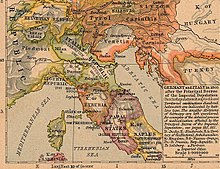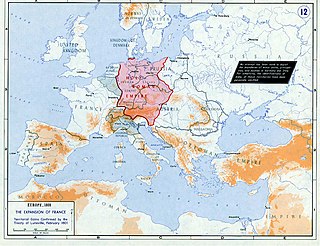
The Treaty of Lunéville was signed in the Treaty House of Lunéville on 9 February 1801. The signatory parties were the French Republic and Emperor Francis II, who signed on his own behalf as ruler of the hereditary domains of the House of Austria and on behalf of the Holy Roman Empire. The signatories were Joseph Bonaparte and Count Ludwig von Cobenzl, the Austrian foreign minister. The treaty formally ended Austrian and Imperial participation in the War of the Second Coalition and the French Revolutionary Wars.

The Treaty of Campo Formio was signed on 17 October 1797 by Napoleon Bonaparte and Count Philipp von Cobenzl as representatives of the French Republic and the Austrian monarchy, respectively. The treaty followed the armistice of Leoben, which had been forced on the Habsburgs by Napoleon's victorious campaign in Italy. It ended the War of the First Coalition and left Great Britain fighting alone against revolutionary France.

The Cisalpine Republic was a sister republic of France in Northern Italy that existed from 1797 to 1799, with a second version until 1802.

The War of the Second Coalition was the second war on revolutionary France by most of the European monarchies, led by Britain, Austria, and Russia and including the Ottoman Empire, Portugal, Naples and various German monarchies. Prussia did not join the coalition, and Spain supported France.
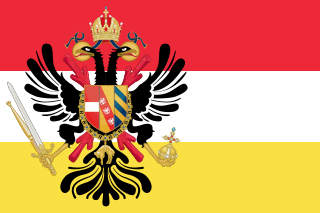
The Austrian Netherlands was the territory of the Burgundian Circle of the Holy Roman Empire between 1714 and 1797. The period began with the Austrian acquisition of the former Spanish Netherlands under the Treaty of Rastatt in 1714 and lasted until Revolutionary France annexed the territory during the aftermath of the Battle of Sprimont in 1794 and the Peace of Basel in 1795. Austria relinquished its claim on the province in 1797 by the Treaty of Campo Formio.

The Duchy of Milan was a state in Northern Italy, created in 1395 by Gian Galeazzo Visconti, then the lord of Milan, and a member of the important Visconti family, which had been ruling the city since 1277.

The Habsburg monarchy, also known as Habsburg Empire, was the collection of empires, kingdoms, duchies, counties and other polities that were ruled by the House of Habsburg. From the 18th century it is also referred to as the Danubian monarchy or the Austrian monarchy.

The Cisrhenian Republic was a planned client state during the French Revolutionary Wars in 1797 on the Left Bank of the Rhine under occupation by France, where the Coup of 18 Fructidor caused a decision to annex the area instead.
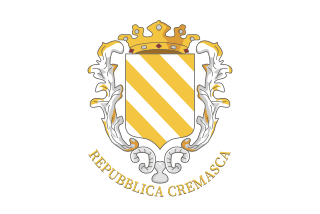
The Republic of Crema was a revolutionary municipality in Lombardy, which was created when the French Army entered Crema on 28 March 1797. It ruled the local affairs of the city and its Neighbourhood, which previously were a Venetian exclave in the Duchy of Milan. The municipality entered then into the Cisalpine Republic in July 1797.

The Austrian Littoral was a crown land (Kronland) of the Austrian Empire, established in 1849. It consisted of three regions: the Margraviate of Istria in the south, Gorizia and Gradisca in the north, and the Imperial Free City of Trieste in the middle. The region has been contested frequently, with parts of it controlled at various times by the Republic of Venice, Austria-Hungary, Italy, and Yugoslavia among others.

The Kingdom of Italy, also called Imperial Italy, was one of the constituent kingdoms of the Holy Roman Empire, along with the kingdoms of Germany, Bohemia, and Burgundy. It originally comprised large parts of northern and central Italy. Its original capital was Pavia until the 11th century.
Campolongo al Torre is a former comune of the Province of Udine in the Italian region Friuli Venezia Giulia, located about 40 km northwest of Trieste and about 25 km southeast of Udine. Since 2009 it has been one of the two principal centres of Campolongo Tapogliano, a municipality formed by its merger with the former comune of Tapogliano.

The Peace of Leoben was a general armistice and preliminary peace agreement between the Holy Roman Empire and the First French Republic that ended the War of the First Coalition. It was signed at Eggenwaldsches Gartenhaus, near Leoben, on 18 April 1797 by General Maximilian von Merveldt and the Marquis of Gallo on behalf of the Emperor Francis II and by General Napoléon Bonaparte on behalf of the French Directory. Ratifications were exchanged in Montebello on 24 May, and the treaty came into effect immediately.
The Republic of Bergamo was an ephemeral revolutionary client republic, created on 13 March 1797 by the French army to rule the local administration of Bergamo and its province, during the dissolution of the Republic of Venice. With the Preliminary of Leoben, France and Austria agreed the end of the multi-centennial Venetian rule over the territory between Adda River and Oglio River, together with the Austrian occupation of Istria and Dalmatia.
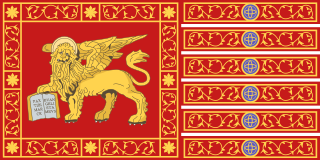
Venetian Albania was the official term for several possessions of the Republic of Venice in the southeastern Adriatic, encompassing coastal territories primarily in present-day southern Montenegro and partially in northern Albania.

The Domini di Terraferma was the hinterland territories of the Republic of Venice beyond the Adriatic coast in Northeast Italy. They were one of the three subdivisions of the Republic's possessions, the other two being the original Dogado (Duchy) and the Stato da Màr.

The Republic of San Marco or the Venetian Republic was an Italian revolutionary state which existed for 17 months in 1848–1849. Based on the Venetian Lagoon, it extended into most of Venetia, or the Terraferma territory of the Republic of Venice, suppressed 51 years earlier in the French Revolutionary Wars. After declaring independence from the Habsburg Austrian Empire, the republic later joined the Kingdom of Sardinia in an attempt, led by the latter, to unite northern Italy against foreign domination. But the First Italian War of Independence ended in the defeat of Sardinia, and Austrian forces reconquered the Republic of San Marco on 28 August 1849 following a long siege.

The Peace of Pressburg was signed in Pressburg on 26 December 1805 between French Emperor Napoleon Bonaparte and Holy Roman Emperor Francis II, as a consequence of the French victory over the Russians and Austrians at the Battle of Austerlitz. A truce was agreed on 4 December, and negotiations for the treaty began. The treaty was signed by Johann I Joseph, Prince of Liechtenstein, and the Hungarian Count Ignác Gyulay for the Austrian Empire and Charles Maurice de Talleyrand for France.

The grand title of the emperor of Austria was the official list of the crowns, titles, and dignities which the emperors of Austria carried from the foundation of the empire in 1804 until the end of the monarchy in 1918.

The Republic of Venice was dissolved and dismembered by the French general Napoleon Bonaparte and the Habsburg Monarchy on 12 May 1797.
